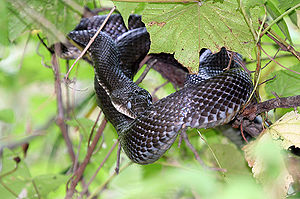Rat snake
| Rat Snake | |
|---|---|

| |
| An Aesculapian Snake, Zamenis longissimus | |
| Scientific classification | |
| Kingdom: | |
| Phylum: | |
| Subphylum: | |
| Class: | |
| Subclass: | |
| Infraclass: | |
| Superorder: | |
| Order: | |
| Infraorder: | |
| Family: | |
| Genus: | Various
|
Rat snakes are medium to large constrictors that can be found through a great portion of the northern hemisphere. They feed primarily on rodents and birds and, with some species exceeding 3 m (10 feet), they can occupy top levels of some food chains. Many species make attractive and docile pets and one, the corn snake, is one of the most popular reptile pets in the world. Other species can be very skittish and sometimes aggressive but bites are seldom serious. As with nearly all colubrids, rat snakes pose no threat to humans. Rat snakes were long thought to be completely nonvenomous, but recent studies have shown that some Old World species do possess small amounts of venom (amounts so small as to be negligible to humans).
Previously, most rat snakes were assigned to the genus Elaphe but many have been since renamed following mitochondrial DNA analysis performed in 2002. For the purpose of this article names will be harmonized with the TIGR Database. When searching for information on a particular species of rat snake it might be useful to query the old name, Elaphe sp., as well as the new.





Species
Old World
- Philippine rat snake (Coelognathus erythrurus) DUMÉRIL, BIBRON & DUMÉRIL 1854
- Yellow rat snake (Coelognathus flavolineatus) SCHLEGEL 1837
- Trinket snake (Coelognathus helena) DAUDIN 1803
- Copperhead rat snake (Coelognathus radiata) BOIE 1827
- Indonesian Rat snake (Coelognathus subradiata) SCHLEGEL 1837
- Twin-spotted rat snake (Elaphe bimaculata) SCHMIDT 1925
- King rat snake (Elaphe carinata) GÜNTHER 1864
- Japanese rat snake (Elaphe climacophora) BOIE 1826
- David's rat snake (Elaphe davidi) SAUVAGE 1884
- Dione rat snake (Elaphe dione) PALLAS 1773
- Japanese four-lined rat snake (Elaphe quadrivirgata) BOIE 1826
- Four-lined snake (Elaphe quatuorlineata) LACEPEDE 1789
- Red-backed rat snake (Elaphe rufodorsata) CANTOR 1842
- Eastern four-lined snake (Elaphe sauromates) PALLAS 1811
- Russian rat snake (Elaphe schrenckii) STRAUCH 1873
- Japanese forest rat snake (Euprepiophis conspicillatus)
- Mandarin rat snake (Euprepiophis mandarinus)
- Celebes black-tailed rat snake (Gonyosoma jansenii) BLEEKER 1858
- Red-tailed green rat snake (Gonyosoma oxycephalum) BOIE 1827
- Mountain rat snake (Oreocryptophis porphyracea) CANTOR 1839
- Cantor's rat snake (Orthriophis cantoris) BOULENGER 1894
- Hodgson's rat snake (Orthriophis hodgsoni) GÜNTHER 1860
- 100 Flower rat snake (Orthriophis moellendorffi) BOETTGER 1886
- Beauty Snake (Orthriophis taeniurus) COPE 1861
- Keeled rat snake (Ptyas carinata) GÜNTHER 1858
- (Ptyas dhumnades) CANTOR 1842
- Sulawesi black racer (Ptyas dipsas) SCHLEGEL 1837
- White-bellied rat snake(Ptyas fusca) GÜNTHER 1858
- Chinese rat snake (Ptyas korros) SCHLEGEL 1837
- (Ptyas luzonensis) GÜNTHER 1873
- Oriental rat snake (Ptyas mucosus) LINNAEUS 1758
- Green rat snake (Ptyas nigromarginatus) BLYTH 1854
- Green trinket snake (Rhadinophis frenatum) GRAY 1853
- Green bush snake (Rhadinophis prasina) BLYTH 1854
- Rhinoceros Ratsnake (Rhynchophis boulengeri) MOCQUARD 1897
- Transcaucasian rat snake (Zamenis hohenackeri) STRAUCH 1873
- Italian Aesculapian snake (Zamenis lineatus) CAMERANO 1891
- Aesculapian snake (Zamenis longissimus) LAURENTI 1768
- Persian rat snake (Zamenis persicus) WERNER 1913
- Leopard snake (Zamenis situla) LINNAEUS 1758
New World
- Baja California rat snake (Bogertophis rosaliae) MOCQUARD 1899
- Trans Pecos rat snake (Bogertophis subocularis) BROWN 1901
- Eastern rat snake (Elaphe alleghaniensis) HOLBROOK 1836
- Baird's rat snake (Elaphe bairdi) YARROW 1880
- Great Plains rat snake (Elaphe emoryi) BAIRD & GIRARD 1853
- Eastern fox snake (Elaphe gloydi) CONANT 1940
- Corn snake (Elaphe guttata) LINNAEUS 1766
- Western rat snake (Elaphe obsoleta) SAY 1823
- Central rat snake (Elaphe spiloides) DUMÉRIL, BIBRON & DUMÉRIL 1854
- Western foxsnake (Elaphe vulpina) BAIRD & GIRARD 1853
- Mexican nightsnake (Pseudelaphe flavirufus) COPE 1867
- Green rat snake (Senticolis triaspis) COPE 1866
See also
Taxonomy
In recent years there has been some taxonomic controversy over the genus of North American rat snakes. Based on mitochondrial DNA, Utiger et al. (2002) showed that North American Rat Snakes of the genus Elaphe along with closely related genera such as Pituophis and Lampropeltis form a monophyletic group separate from Old World members of the genus. They therefore suggested the resurrection of the available name Pantherophis Fitzinger for all North American taxa (north of Mexico).[1]
All published taxonomy remains a taxonomic suggestion until ruled on by the International Commission on Zoological Nomenclature (ICZN - http://www.iczn.org/), but the body has so far not supported the change and has not addressed the taxonomic suggestion, thus the official taxonomy remains Elaphe.
Crother et al. (2003) rejected the taxonomic change to Pantherophis, preferring to retain the current concept of Elaphe and the spelling obsoleta.[2]
Rat snakes in captivity
Rat snakes are commonly kept as pets by reptile enthusiasts. The corn snake is one of the most popular pet reptiles, and belongs to the rat snake family. New world species are generally thought to be more docile in captivity as opposed to old world rat snakes, of which the opposite is assumed.
References
- ^ Elaphe obsoleta at The Center for North American Herpetology. Accessed 20 June 2008.
- ^ Crother BI, Boundy J, Campbell JA, De Quieroz K, Frost D, Green DM, Highton R, Iverson JB, McDiarmid RW, Meylan PA, Reeder TW, Seidel ME, Sites Jr JW, Tilley SG, Wake DB. 2003. Scientific and Standard English Names of Amphibians and Reptiles of North America North of Mexico: Update. Herp. Rev. 34: 196-203. PDF at Southeastern Louisiana University. Accessed 11 December 2010.
External links
<references>
